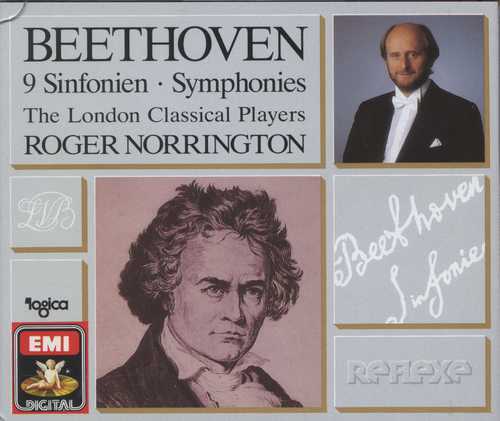
Composer: Ludwig van Beethoven
Performer: The London Classical Players, Yvonne Kenny, Sarah Walker, Patrick Power, Petteri Salomaa, The Schütz Choir of London
Conductor: Roger Norrington
Audio CD
SPARS Code: DDD
Number of Discs: 6 CD box set
Format: FLAC (tracks+cue)
Label: EMI
Size: 1.35 GB
Recovery: +3%
Scan: yes
Disc: 1
01. Symphony No. 1 in C, Op. 21: I: Adagio molto-Allegro con brio
02. Symphony No. 1 in C, Op. 21: II: Andante cantabile con moto
03. Symphony No. 1 in C, Op. 21: III: Menuetto: Allegro molto e vivace
04. Symphony No. 1 in C, Op. 21: IV: Adagio-Allegro molto e vivace
05. Symphony No. 6 in F, Op. 68 ‘Pastoral’: I: Allegro ma non troppo
06. Symphony No. 6 in F, Op. 68 ‘Pastoral’: II: Andante molto moto
07. Symphony No. 6 in F, Op. 68 ‘Pastoral’: III: Allegro
08. Symphony No. 6 in F, Op. 68 ‘Pastoral’: IV: Allegro
09. Symphony No. 6 in F, Op. 68 ‘Pastoral’: V: Allegreto
Disc: 2
01. Symphony No. 2 in D, Op. 36: I: Adagio molto-Allegro con brio
02. Symphony No. 2 in D, Op. 36: II: Larghetto
03. Symphony No. 2 in D, Op. 36: III: Scherzo (Allegro)
04. Symphony No. 2 in D, Op. 36: IV: Alegro molto
05. Symphony No.8 in F, Op. 93: I: Allegro vivace e con brio
06. Symphony No.8 in F, Op. 93: II: Allegretto scherzando
07. Symphony No.8 in F, Op. 93: III: Tempo di Menuetto
08. Symphony No.8 in F, Op. 93: IV: Allegro vivace
Disc: 3
01. Overture: The Creatures of Promethus, Op.43
02. Symphony No. 3 in E flat, Op. 55 ‘Erioca’: I: Allegro con brio
03. Symphony No. 3 in E flat, Op. 55 ‘Erioca’: II: Marcia funebre. Adagio assai
04. Symphony No. 3 in E flat, Op. 55 ‘Erioca’: III: Scherzo Allegro vivace
05. Symphony No. 3 in E flat, Op. 55 ‘Erioca’: IV: Finale: Allegro molto-Poco andante-Presto
Disc: 4
01. Symphony No. 4 in B flat, Op. 60: I: Adagio-Allegro vivace
02. Symphony No. 4 in B flat, Op. 60: II: Adagio
03. Symphony No. 4 in B flat, Op. 60: III: Allegro vivave-Trio: Un poco meno Allegro
04. Symphony No. 4 in B flat, Op. 60: IV: Allegro ma non troppo
05. Symphony No. 5 in c, Op. 67: I: Allegro con brio
06. Symphony No. 5 in c, Op. 67: II: Andante con moto
07. Symphony No. 5 in c, Op. 67: III: Allegro
08. Symphony No. 5 in c, Op. 67: IV: Allegro-Presto
Disc: 5
01. Overture to Collin’s tragedy ‘Coriolan’, Op.62
02. Overture to Goethe’s tragedy ‘Egmont’, Op. 84
03. Symphony No. 7 in A, Op. 92: I: Poco sostenuto-Vivace
04. Symphony No. 7 in A, Op. 92: II: Allegretto
05. Symphony No. 7 in A, Op. 92: III Presto-Assai meno presto
06. Symphony No. 7 in A, Op. 92: IV: Allegro con brio
Disc: 6
01. Symphony No. 9 in d, Op. 125: I: Allegro ma non troppo,un poco maestoso
02. Symphony No. 9 in d, Op. 125: II: Molto vivace-Presto-Molto vivace-Presto
03. Symphony No. 9 in d, Op. 125
04. Symphony No. 9 in d, Op. 125
05. Symphony No. 9 in d, Op. 125: III: Adagio molto e cantabile-Tempo I-Andante moderato-Adagio
06. Symphony No. 9 in d, Op. 125: IV: Presto-Allegro ma non troppo-Tempo I-Vivace-Tempo I-Adagio
07. Symphony No. 9 in d, Op. 125:-Presto-Recitative-Allegro assai
08. Symphony No. 9 in d, Op. 125:-Allegro assai vivace. alla marcia
09. Symphony No. 9 in d, Op. 125:-Andante maestoso-Adagio ma non troppo, ma divoto
10. Symphony No. 9 in d, Op. 125:-Allegro energico, sempre ben marcato
11. Symphony No. 9 in d, Op. 125:-Allegro ma non tanto-Poco adagio-Tempo I-Poco adagio
12. Symphony No. 9 in d, Op.125:-Poco allegro-stringendo il tempo, sempre piu allegro-Prestissimo
norrington_beethoven__9_symphonies_cd_2.rar – 245.5 MB
norrington_beethoven__9_symphonies_cd_3.rar – 195.7 MB
norrington_beethoven__9_symphonies_cd_4.rar – 258.3 MB
norrington_beethoven__9_symphonies_cd_5.rar – 216.3 MB
norrington_beethoven__9_symphonies_cd_6.rar – 242.7 MB
uniquely passionate performances…
I strongly disagree with the Amazon reviewer concerning his comment about how “musically empty” this set is. I find Norrington’s performances of the 2nd, 3rd, 4th, 5th, 7th, and 8th symphonies to be exceptionally well-conceived, full of passion–as Beethoven would have wanted–and largely faithful to the original scores. Admittedly, later sets by Bruggen and Gardiner may be more consistently well-played than this set, but you could say that about many of pioneering period performances from the 1980s–including even Pinnock’s critically acclaimed Brandenburg Concertos, or Hogwood’s groundbreaking set of Mozart symphonies, and to do so misses the point. What was so exciting about the early days of the period movement was the extraordinary sense of musical discovery that these performances brought to both listeners and musicians alike–regarding the original scores. As much as I loved my Karl Bohm recordings of Mozart symphonies, the first time that I heard Hogwood’s recording of the “Prague” symphony was a revelation. No longer would Bohm’s rather Brahmsian approach to these works suffice–clearly, this approach was not what Mozart had in mind. Indeed, it was as if I was hearing Mozart for the very first time. Yes, generally speaking, higher standards of performance were later attained, but there is still something remarkably exciting about many of these early recordings–whatever their flaws may be–and we shouldn’t forget that, or how daringly new they were at the time.
The first box set issue of Norrington’s watershed Beethoven cycle
I imagine that the first Norrington cycle of Beethoven is like a watershed in the recorded history of these symphonies. In these recordings Norrington attempted to show the public that it is possible to keep to the marked speeds that Beethoven left in his scores. Although other conductors had attempted to adhere to these speeds, the Norrington recordings were among the first widely disseminated recordings that observed them closely. This box set is the original issue of the cycle before its budget price incarnations. As such it presents the CDs as they were originally issued and includes the original sleeve notes and Norrington’s performance notes.
I am aware that HIP in anything means the hurry-up culture and rush-hour speeds. I am also aware that there is mounting evidence to suggest that the ensembles and musicians of the Baroque and Classical era needed to adopt slow speeds out of necessity because of ragged ensemble standards and sluggish internal instrument mechanics. With this in mind, I imagine that there will still be a place for the Boehm, Wand and Klemperer recordings as antidotes to this malady of hurry in modern-day music-making. However, the likes of Norrington and Gardiner make persuasive cases of returning to the extant markings and speeds that Beethoven left us. The music feels less soupy and you feel as if the music is better at evoking Beethoven’s ruffianly manner. Every section gets the chance to shine and not be overwhelmed by the tyranny of massive string sections. It would be good to remember that some of yesteryear’s conductors adopted faster than normal speeds so that their recordings could fit onto the limited capacity of the recording medium. The Walter and Horenstein recordings of the Choral ran for 67 minutes and were still fitted onto a single LP. In any case, I am grateful that the likes of Norrington, Hogwood and Gardiner removed the stodge from past performances of this music and made it sound fresh and vital.
The Norrington cycle was the first period instrument cycle to establish itself in the catalogue and acquire a following. The whole box and the individual recordings have been reissued multiple times. This black budget-price box set allowed listeners to acquire the cycle at a cheap price and hear what the fuss was about. Although EMI-Virgin subsequently combined the symphonies and the piano concertos into a box set, it would be good if I could post my review of the symphonies here so others can read it.
Although Norrington and the LCP offer committed performances, I note some small issues with the playing. I find that the bow strokes of the strings could have been a little stronger. Also, I felt that the phrasing did not always seem to take flight. This problem is not that pronounced in the short symphonies, but I did feel that he underplays the moments of high emotion in the Eroica and the Choral, especially when the contrasts between sections are gentle and less marked than in other recordings. Even so, Norrington offers clear textures and better-defined rhythms in the inner voices.
The four short symphonies do not present a problem for Norrington and his orchestra. Of these symphonies I note that the Second and the Eighth come off better than the First and the Fourth. The coupling of the Second and the Eighth was the first Norrington Beethoven release. These two symphonies sound a bit more vigorous and vivid, and Norrington is attentive to the subtleties and details in these scores, such as the telling brass fanfares in the first movement of the Second. The First and Fourth have well-sprung rhythms, but I find that some of the louder parts could do with a bit more projection. However, throughout these symphonies, the winds still have a chance to step out and shine. The only concern is in the slow movement of the Fourth. Norrington’s fast speed does not quite allow the movement to spin itself out. Also, the dotted rhythm does not articulate its character in the winsom way it does on the Harnoncourt, Mackerras or Antonini versions. Generally, the short symphonies come off quite well.
Norrington and his orchestra might have some trouble with the heavier middle-period symphonies, notably in the Eroica and the Fifth. In these two symphonies I note that they tend to underplay the moments of high emotion. For instance, the discords in the development of the Eroica could be a bit brasher and assert themselves more, and the final statement of the finale theme could have a bit more gravitas. Norrington’s Fifth is a tight, well-argued performance. However, I note that the first two movements haven’t got that nervous tension that marks the successful performances of this piece. In both the Eroica and the Fifth, Norrington does better in handling the later two movements. Despite this concern, I appreciate Norrington highlighting telling details in both symphonies.
Of the other middle-period symphonies, Norrington offers a successful reading of the Pastoral. I know that the Pastoral demands a sense of the “long now” from conductors who can adopt leisurely speeds and make the moment last. By this criteria, the Pastorals by the likes of Bohm, Klemperer or Wand might be ballast against the hurry culture of many recent Pastorals. However, the likes of Norrington, Gardiner and Mackerras have shown us that the music can still make sense at Beethoven’s speeds. The outer movements have a spring in its step and the second movement benefits from affectionate string phrases. I did feel doubtful about the storm, as it could be a bit more shattering. After hearing this Norrington version of the Pastoral, it strikes me as one of the stronger points in his cycle, with attentive phrasing and felicitous wind playing. Norrington also handles the Seventh quite well, and offers a “gaily tripping, lightly skipping” performance. I know that it may not be as visceral as the Carlos Kleiber, Harnoncourt or Mackerras versions, but Norrington’s rhythms are well sprung and he highlights many details. There may be some rough patches in the first movement, but this account of the Seventh finds its footing in the second movement.
The Norrington version of the Choral was the first period instrument version of the symphony to be made. It may have its rough patches in the second and fourth movements, but we should give credit to Norington for pleading the case for keeping to Beethoven’s marked speeds. I know that the HIP approach to the Choral promotes the hurry culture and removes the profound utterances until the symphony becomes another aimless divertimento. However, it is refreshing to hear performances of the Choral that attempt to keep to the marked speeds that Beethoven left us. In Norrington’s version of the Choral, as in Hogwood’s, I find that the first and third movements come off better. They are not afflicted by patches of faulty speeds that you encounter in the second and fourth movements. I admit that Norrington tends to underplay the moments of high emotion in the first movement, but he allows the argument to unfold naturally at a steady pace. He also allows the winds to step out and shine. The second movement Scherzo fares fine, but the Trio stalls at the slow pace of 116 minims. The third movement is steady, although I wished that the phrasing could be a bit more sculpted.
The instrumental part of the choral finale came off fine, but I was not too happy when the singers and chorus entered. I was not too happy with the unsteady singing of the male soloists. I also wince when hearing Norrington adopt the ultra-slow speed for the Allegro assai vivace. At that time, Norrington took the speed of 84 dotted crotchets at face value. This was before the research that suggested this was a misprint and that this should be twice as fast (84 dotted minims.) I know that conductors who adopt a fast speed for this section risk turning it into a Gilbert & Sullivan patter song and taxing the singers and players who need to play those fast quavers. However, this section shares a family likeness with the march variation in the Choral Fantasy. As such the kinship with the sketch for the choral finale can justify this speed. The movement finds its footing at the Seid umschlungen Millionen section, and Norrington manages to turn up the heat in the double fugue. The soloists have no problem with the Allegro ma non tanto before the rousing account of the final Presto section.
The Norrington cycle is comparatively more established in the catalogue and has acquired a following as the individual discs were issued. Despite its rough patches, Norrington and the LCP have shown us that it is possible to play these symphonies convincingly at Beethoven’s original speeds. Of all the historically informed cycles of Beethoven, I am still as fond as ever of Gardiner’s robust DG Archiv cycle. I know that prominent cycles like his or Karajan’s would have been promoted by corrupt commercial practices and that listeners might turn towards the marginalised versions by the likes of Bruggen or Cluytens, but the robustness in Gardiner’s set has won me over and made more of an impact on me than these Norrington recordings did. In any case, despite the problems I face as a listener, I imagine that this Norrington cycle might be more deserving of a place in history than the other period instrument cycles.
I would give 5 stars for the First, Second and Eighth, 4 and a half stars for the Fourth, Pastoral and Seventh, 4 stars for the Fifth, and 3 and a half stars for the Eroica and the Choral.
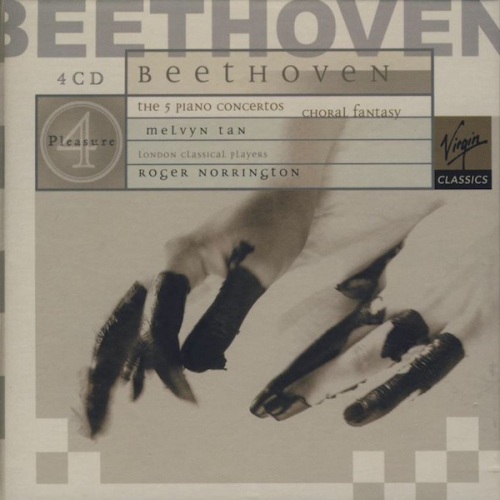
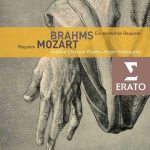
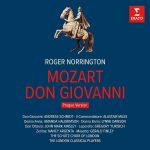
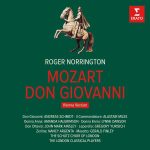
Gracias!
still one of my favorite sets :)
TNX!
The only reason I’m downloading this set, to be honest, is curiosity. This set was all the rage when it came out (praised above all in England, some say by patriotic reasons), and was bashed by many critics later on. I’m interested in forming my own opinion. Other cycle I’d like to hear as soon as I can put my hands on is that of Mariss Jansons. It is supposd to be quite good.
Thank you for the post, Mr. Whatever!
Very interesting comments, I’m looking forward to listening to these versions of the symphonies! Happy listening to all
i always loved this set ¡¡¡ I’d rather listen this version than karajan’s, solti and others “old versions” ¡¡¡
lovely set! Thank You!
Thanks Whatever…can’t wait to hear these.
I remember that these performances were generally very well received upon their first release. It’s not like we were unused to period performances of Beethoven’s symphonies at that time. And there were many wondefull performances, as there are still of these great works played by modern symphony orchestras. My biggest single problem with this cycle was Norrington’s dreafully SLOW tempo in the alla marcia section in the last movement of the ninth. The music itself sreamed WRONG WRONG WRONG but on he goes only to discover long after that the tempi marked by Beethoven was twice the speed adopted by Norrington who had – as did others at the time – misread the metronome marking. there are so many sets of the Beethoven symphonies now on period instrument now that this set seems very “old hat” now.
Hi,
thanks for this set. :grin:
Apparently Norrington was one of the first conductors to apply the tempos actually written by Beethoven (!)
In the old days of Reiner, Solti, Karajan etc. these tempos seemed outrageous because the narration of the music was lost in the modern-day great symphony orchestra. With original instrument technique and a smaller ensemble these tempos make more sense but still – I remember the noise made by critics then. :-)
Interesting comment, Sandflyer!
Danke..
I remember when this came out, one of the first original instrument performances of these symphonies everybody was disgusted with the fast tempos. Now, it seems, these have become “classic performances”. Thanks for the chance to listen to them again!